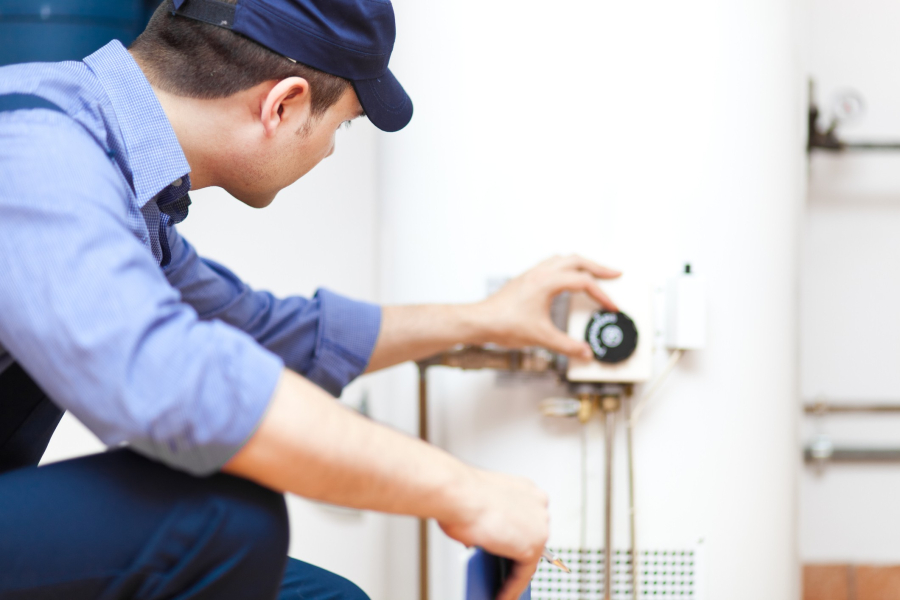
Regular water heater maintenance is a vital practice for maintaining the comfort, safety, and efficiency of your home. Neglecting this important task can result in a range of problems, from reduced efficiency and higher energy costs to potentially dangerous situations such as leaks or malfunctions.
By making water heater maintenance a priority, you do more than just prolong the life of your appliance. You ensure that it operates at peak efficiency, providing a steady and reliable supply of hot water for all your daily needs. Furthermore, regular maintenance helps you identify and address minor issues before they escalate into major problems, saving you time, money, and inconvenience in the long run.
Understanding Your Water Heater
To effectively maintain your water heater, it's essential to have a basic understanding of its type and components. This knowledge will guide you in performing the right maintenance tasks and identifying potential issues before they escalate.
Types of Water Heaters
- Tank Water Heaters
These traditional water heaters store a large volume of hot water in a tank, typically ranging from 20 to 80 gallons. They can be powered by electricity, natural gas, propane, or oil. - Tankless Water Heaters
Also known as on-demand water heaters, tankless models heat water directly without the use of a storage tank. They offer a continuous supply of hot water and are known for their energy efficiency. - Solar Water Heaters
These eco-friendly systems use solar panels to collect and convert sunlight into heat, which is then used to warm the water. They often include a backup system for cloudy days. - Heat Pump Water Heaters
These units use electricity to move heat from the air or ground to the water, making them significantly more energy-efficient than conventional electric water heaters.
Key Components of a Water Heater
- Anode Rod
This sacrificial rod helps prevent corrosion of the tank by attracting corrosive elements in the water. Regular inspection and replacement are crucial for tank longevity. - Thermostat
This component regulates the temperature of the water in the tank. It's essential to ensure it's functioning correctly to avoid overheating or insufficient heating. - Heating Elements
In electric water heaters, these elements are responsible for heating the water. They can wear out over time and may need replacement. - Pressure Relief Valve
This safety valve releases pressure if it exceeds safe levels, preventing potential explosions. Regular testing is important to ensure it operates correctly.
Understanding these types and components will empower you to carry out effective maintenance and troubleshoot any issues that may arise with your water heater.
Essential Water Heater Maintenance Tips
Regularly scheduled checks and upkeep not only prevent unexpected breakdowns but also optimize the system's performance, leading to energy savings and consistent hot water supply. By adhering to a set of fundamental water heater maintenance practices, you can significantly reduce the risk of malfunctions and extend the lifespan of your water heater, ensuring it remains a reliable source of comfort in your home.
Regular Inspections
- Visual Checks: Periodically inspect your water heater for any signs of wear, rust, or leakage. Pay special attention to the area around the base and the connections for any signs of moisture.
- Listen for Noises: Unusual sounds, such as popping or rumbling, could indicate sediment buildup in the tank, which requires attention.
Draining and Flushing the Tank
- Turn Off Power: For safety, turn off the power to the water heater at the circuit breaker (for electric heaters) or set the gas valve to "pilot" (for gas heaters).
- Connect a Hose: Attach a garden hose to the drain valve at the bottom of the tank and run it to a suitable drain or outside area.
- Open the Drain Valve: Allow the water to flow out, which will help remove any sediment that has settled at the bottom of the tank.
- Flush the Tank: After draining, briefly open the cold water supply valve to flush any remaining sediment from the tank. Repeat this process until the water runs clear.
- Refill the Tank: Close the drain valve, remove the hose, and refill the tank by opening the cold water supply valve. Ensure the tank is fully refilled before turning the power back on.
Checking the Anode Rod
- Locate and Remove: The anode rod is usually located at the top of the water heater. Unscrew it using a socket wrench and carefully remove it from the tank.
- Inspect: Check the rod for significant wear or corrosion. If it's more than half depleted, it's time to replace it.
- Replace: Insert a new anode rod and tighten it securely to prevent leaks.
Temperature and Pressure Relief Valve Testing
- Locate the Valve: The T&P valve is usually found on the top or side of the tank.
- Test: Lift the lever on the valve to release a small amount of water. If water flows freely and then stops when you release the lever, the valve is functioning correctly.
- Monitor: If the valve does not release water or continues to drip after testing, it may need to be replaced.
Advanced Water Heater Maintenance Techniques
Beyond the basics, there are advanced techniques you can employ to further enhance the performance and efficiency of your water heater. These strategies go a step further in optimizing your system, focusing on energy conservation, temperature regulation, and insulation improvements.
By implementing these advanced methods, you can fine-tune your water heater's operation, achieving greater efficiency, reducing environmental impact, and ultimately saving on energy costs. These techniques are especially beneficial for homeowners looking to maximize their water heater's potential and ensure its peak performance over time.
Insulating the Water Heater
- Tank Insulation
If you have a tank-style water heater, consider wrapping it in an insulation blanket. This reduces heat loss, helping the water stay warm longer and reducing the energy required to maintain the temperature. - Pipe Insulation
Insulate the first few feet of the hot and cold water pipes connected to the water heater. This can prevent heat loss from the pipes, ensuring that your hot water arrives at the tap with minimal temperature drop.
Adjusting the Temperature Setting
- Optimal Temperature
The default temperature setting on most water heaters is typically higher than necessary. Lowering the temperature to around 120°F (49°C) can reduce energy consumption while still providing comfortably hot water for most uses. - Safety and Savings
Adjusting the temperature not only saves energy but also reduces the risk of scalding, making it a wise choice for households with young children or elderly residents.
Professional Water Heater Maintenance Services
While regular homeowner maintenance is crucial, there are instances where the expertise of a professional is indispensable. Knowing when to seek professional help and recognizing the advantages of such services can ensure your water heater operates safely and efficiently.
There are several scenarios where calling in a professional is advisable. Persistent unusual noises like rumbling, popping, or whistling from your water heater could indicate sediment buildup or other issues that need professional attention. If your water heater is not providing hot water or if the temperature fluctuates, a professional can diagnose and fix the problem.
Any signs of water leakage around the base of the water heater or from the pipes connected to it should be addressed by a professional to prevent water damage and potential safety hazards.
Even if there are no apparent issues, having a professional perform an annual maintenance check can help identify potential problems and keep the system running smoothly.
For reliable and expert service, consider contacting The Boiler Shoppe for your water heater maintenance or repair needs. Their experienced technicians can provide the necessary care to keep your system in top condition.



